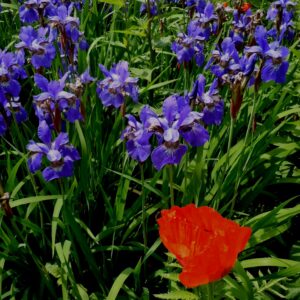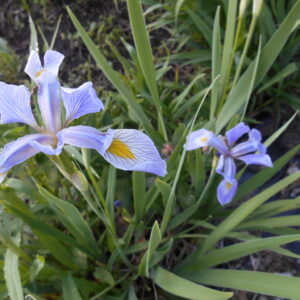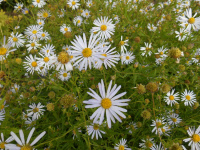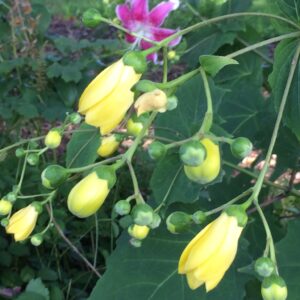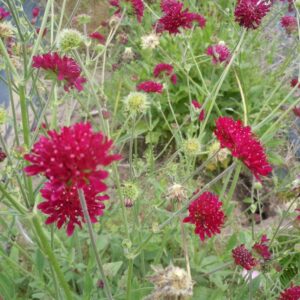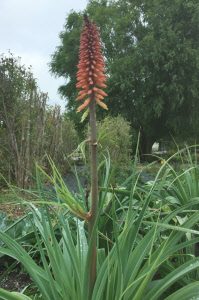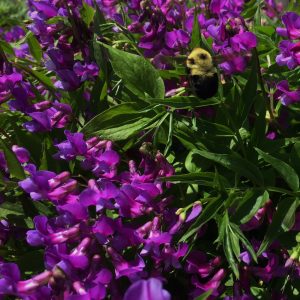Perennials & Biennials
Showing 265–272 of 485 results
-
Iris siberica Siberian Iris Z 4-9
sword shaped leaves with blue, purple or lilac Iris flowers
Narrow, sword shaped leaves with blue, purple, or white Iris flowers in June.
Size: 3-4' x S 12" and spreading
Care: Full sun moist well-drained soil. Deer resistant, Walnut toxicity resistant and drought tolerant.
Native: Eastern Siberia
Awards: England's Royal Horticultural Society Award of Merit.Iris is named after the Greek goddess who accompanied the souls of women to the Elysian Fields by way of the rainbow. Her footprints left flowers the colors of the rainbow. Iris means the “eye of heaven.” The iris is the flower of chivalry, having “a sword for its leaf and a lily for its heart.” Ruskin. Siberian Irises first cultivated in European gardens in the 1500’s. Blue Siberian Iris was introduced to the U.S. in 1796. Cultivated by Washington at Mount Vernon.
-
Iris versicolor Blue flag Z 3-9
Purple, lavender or blue flowers in June
Purple, lavender or blue flowers in June
Size: 36" x 12"
Care: sun, moist to moist well-drained soil
Native: Eastern United States, Wisconsin nativeIris is named after the Greek goddess who accompanied the souls of women to the Elysian Fields by way of the rainbow. Her footprints left flowers the colors of the rainbow. Iris means the eye of heaven. Omaha Indians used the roots topically to cure earaches. Other tribes applied a poultice to cure sores and bruises. Root is poisonous. Cultivated in gardens since the 1700’s.
-
Kalimeris incisa syn. Asteromoea , Kalimeris integrifolia False aster Z 4-8
Pale lavender single daisies that bloom from July – September, deadhead after 1st flush of blooms for repeat flowering
Pale lavender single daisies that bloom from July – September, deadhead after 1st flush of blooms for repeat flowering
Size: 2-3’ x 12”
Care: sun to part shade in moist well-drained to dry soil. Cut back halfway in early June to make bushier with more flowers.
Native: Japan, northern China & SiberiaCollected before 1812 when first named and described. Renamed about five times July 6, 1872 issue of The Garden reported that “Callimeris incise” was blooming in London.
-
Kirengeshoma palmata Yellow Waxbells 5-8
Moon yellow bells – gracefully droop in late summer and fall. One of internationally known garden designer Piet Oudolf’s 100 “MUST HAVE” plants, Gardens Illustrated 94 (2013)
Moon yellow bells – gracefully droop in late summer and fall. One of internationally known garden designer Piet Oudolf’s 100 “MUST HAVE” plants, Gardens Illustrated 94 (2013)
Size: 36" x 30"
Care: part shade to shade in moist to moist well-drained soil
Native: Mt. Ishizuchi in Japan
Wildlife Value: pollinated by bumblebees. deer and rabbit resistant
Awards: Royal Horticultural Society Award of Garden Merit.Kirengeshoma means “yellow” in Japanese. 1st described in Tokyo’s Botanical Society Botanical Magazine in 1890.
-
Knautia macedonica syn. Scabiosa rumelica Pincushion plant Z 5-9
Claret pincushions float at the tips of airy wands all summer & fall
Claret pincushions float at the tips of airy wands all summer & fall
Size: 2- 3’ x 10”
Care: sun in well-drained soil. Keep compact by cutting back to 10” in spring, if you wish
Native: Central Europe
Wildlife Value: attracts butterflies and beesKnautia named for German doctor & botanist Christoph Knaut (1656-1716) who published a method of classifying plants. Collected before 1879
-
Kniphofia caulescens Red hot poker, Regal torch lily Z 5-10
fat spikes of flowers open coral-red, turning pale lemon-yellow
Evergreen perennial with short, stout stems bearing grass-like broad, grey-green leaves. Blooming July to August, fat spikes of flowers open coral-red, turning pale lemon-yellow
Size: 3’ x 2-3’
Care: sun in moist well-drained soil
Native: Lesotho South Africa
Wildlife Value: deer and rabbit resistant. Attracts hummingbirds
Awards: Royal Horticultural Society Award of Garden Merit; Denver Botanic Garden Plant SelectIntroduced to gardens by Mr. T. Cooper about 1860. 1st described by French botanist Carrière in Revue Horticole in 1884
-
Kniphofia triangularis Dwarf Red hot poker Z 5-8
From early to late summer, with dead-heading, vivid coral spikes, like a torch .
From early to late summer, with dead-heading, vivid coral spikes, like a torch. This plant has everything- resistant to deer & rabbits, long blooming, great cut flowers, hummingbirds and butterflies love it.
Size: 2’ x 12-18”
Care: sun in moist to well-drained soil, Drought tolerant once established
Native: mountain grassland & moist areas in the Eastern Cape to the Northern province of South Africa.
Wildlife Value: resistant to deer & rabbits, hummingbirds and butterflies love it.1st described in 1854 in Enumeratio Plantarum Omnium Hucusque Cognitarum, Vol. 4 p. 551
-
Lathyrus vernus Spring vetchling, Spring pea, Spring vetch Z 4-9
Bushy plants bear showy, red-purple pea-like blooms age to rich purple in March-June. Spring gem.
OUT OF STOCK
Bushy plants bear showy, red-purple pea-like blooms age to rich purple in March-June. Spring gem.
Size: 10” x 10”
Care: sun in north to shade in south, moist well-drained soil. Drought tolerant once established
Native: No. Europe - Siberia
Awards: Royal Horticultural Society Award of Garden Merit, Elisabeth Carey Miller Botanical Garden Great Plant PicksIntroduced to gardens before 1629 when herbalist John Parkinson (1567-1650) called it “Blew Everlasting Pease.”

